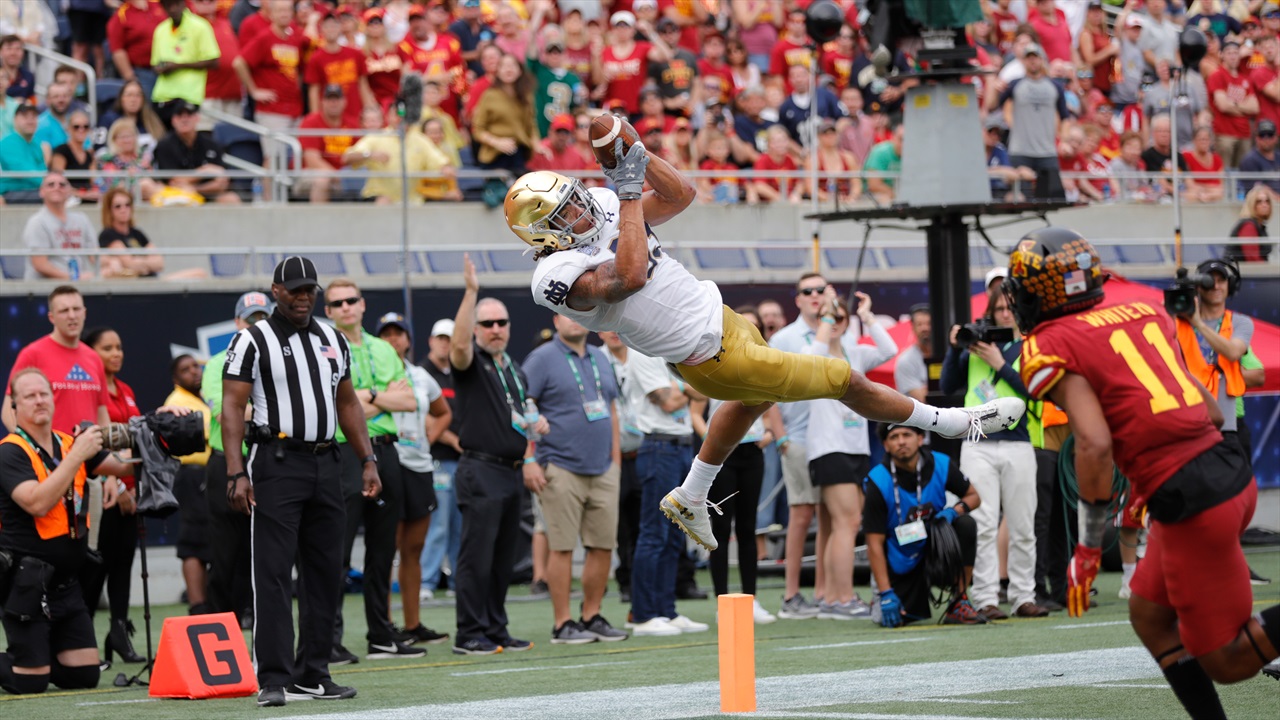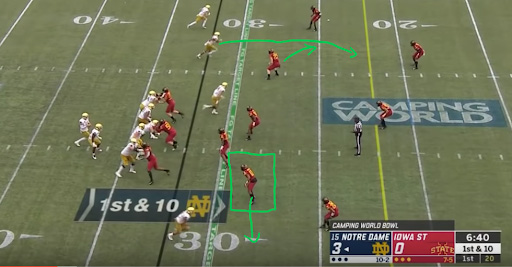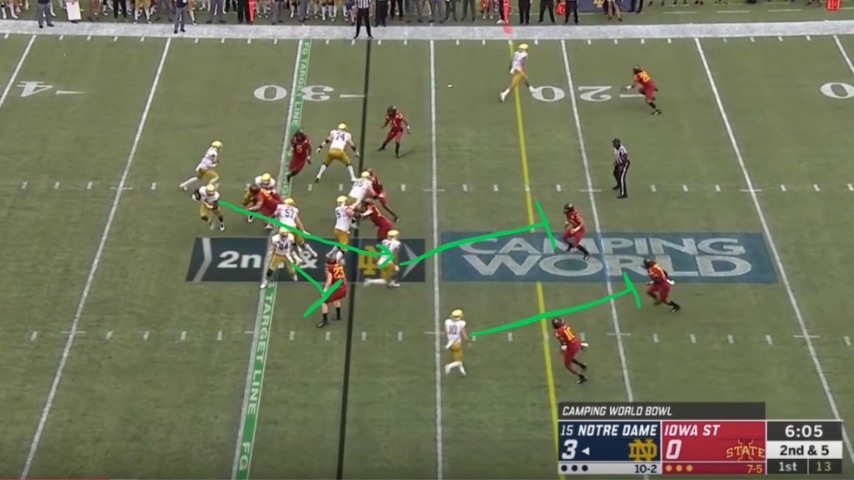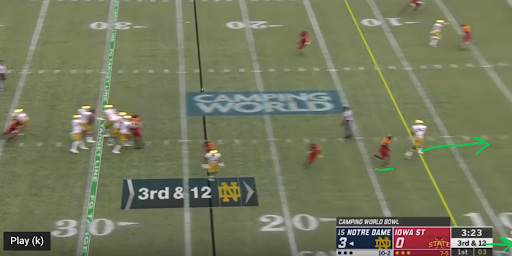
Inside The Headset | Tommy Rees' First TD Drive As OC
“Coach Sting” is a current coach who has spent time on both the high school and college level. He’ll be offering his expertise to Irish Sports Daily by diving into Notre Dame film and explaining what he sees.
We are back with another addition of “Inside the Headset.” If you missed this series’ debut, which looked at Tommy Rees’ first series calling plays for Notre Dame, you can check that out HERE.
Today, we’ll examine Rees’ first touchdown drive as Irish offensive coordinator.
After another Iowa State turnover in the bowl game, the Irish find themselves with the ball on the minus-42 yard line with 7:03 to go in the 1st quarter, up 3-0.
THIRD OFFENSIVE SERIES
PLAY 1
1ST & 10
Rees sends out 21 personnel (2 Backs, 1 TE) and sets the TE and Fullback strong, both into the boundary side. This is a strategic theme for Rees, as we discussed in the first “Inside the Headset,” by getting into heavy personnel versus Iowa State’s 3-3-5 defense and trying to match up a TE/H/FB on undersized Iowa State’s DB, #11. There are two types of ways defenses set their alignment, with subsets below that.
One, used primarily by the Cyclones, is to set a defense based on Field (the wide side) and Boundary (the short side) of the field. The other is by formation (i.e. most WR side, pass strength, run strength, side of the RB, etc).
With the Cyclones being a “field defense” in their personnel alignment, Rees takes advantage of knowing that #11 is a really good player in space, but no physical match for larger bodies. Much like the game’s opening play, Rees manipulates the formation to get two big TE bodies (Cole Kmet & Tommy Tremble lined up as offset FB) to run right at #11.
Under center, Rees dials up another old-school beauty, with a lead wide zone play -- once again attacking the natural bubbles in the 3-man front. All of this works in the favor of the Irish, but there are two additional reasons this play is a big-hitter.
Because Rees had already called the traditional “Power” play four times at this point in the game, the Cyclone Inside LB’s are on a cross blitz up the middle designed for both A-Gaps (the gap between the center and guards) and the backside inside LB is trying to get over the top in a downhill path - both of those things make sense defensively versus Power.
Rees stays one step ahead here as he takes the RB’s path slightly wider with the same initial look in the backfield. This forces the LB’s to react as they would versus Power, allowing the OL to easily seal them with their outside zone path. Take a look at the two Inside LB’s here:

The second part of this run that allows Jones to break free, is the “spy block” or what coaches refer to as a “push-crack” block performed by Chris Finke, who is lined up at the bottom of your screen, playside.
Because of the zone blitz (a non-man coverage blitz with movement), the safety towards the run is rolling down for that zone, the backside safety rolls to the middle of the field and the CB at the bottom is supposed to bail out. All of this happens for Iowa State, but Finke is coached perfectly to push off the LOS and “spy” the safety. This drives the CB back even more, and then Finke blocks the safety who is running down to try and make the play.
Because the LB’s were already sealed off as we discussed, this allows Tremble to block the playside CB! Anytime you can get a lead fullback on a corner, your RB is off to the races. That is exactly what happens here!

This play was set up at the beginning of the quarter and the payoff is just over 26 yards on the ground! 1st & 10 from the plus-32.
PLAY 2
1ST & 10
It’s safe to say Rees knew he was going to draw soft zone coverage here, with no pressure. Not only did he go into one of the only true spread formations so far (Loose 3X1 Trips), the Cyclones were just burned with a cross-blitz the previous play and they have been running the ball effectively in Power formations.
After a big play on the ground from ND, Iowa State was sitting back waiting for what has all the signs of a “shot play” that is usually called during this time by most OC’s (big play -- especially on the ground, just enter the extended Red Zone, and 1st down). Instead, Rees opts to play it safe here and runs a version of a “Stick” concept.
The traditional “Stick” with 3 WR’s is the outside WR runs outside release vertical, the #2 inside WR runs into the flat, and #3 inside WR runs a “Stick route,” which is a quick hitch that rolls outside versus any man coverage on him. Here, the #1 and #2 WR’s switch responsibilities, but get to virtually the same landmarks as a traditional “Stick” concept.
Rees anticipated this soft coverage with the call. If he was going to get blitz man, “Stick” is a really poor call. WR’s don’t typically run hitches versus man and they are coached to convert to verticals, so this play would turn into 3 verticals in that scenario. The boundary throw to Claypool to the bottom is the quickest and shortest throw and the first read, especially against a soft CB (CB at depth in off coverage).

As you can see here, despite the soft CB, Book can’t go to the quick hitch to Claypool because of the extra defender who can get underneath the throw. This is the advantage of a defense who is rushing only 3 and dropping 8 into coverage - on first down.
While this is only a 5-yard completion, this is one of the first real signs that Iowa State’s defense is exactly that -- on the defense and not dictating much of anything.
The #2 inside WR running vertical forces #23 to open his hips and run with the WR initially, preventing him from getting underneath the #1 WR to the field, like the boundary side.
All of this results in a solid throw that travels a long way, but thrown on a rope to Finke. Book recognizing the underneath defender to the boundary pre-snap is key because it allows him to get rid of this ball immediately, which is always helpful for a throw to the wide side of the field.
Complete for 5 yards.
PLAY 3
2ND & 5
On 2nd & 5, with the Cyclones on their heels, Rees goes right back to Outside Zone, which was very successful on the first play of this drive. As most great OC’s do, he goes with the same call up front, with a change in presentation (a different formation and look), by being in shotgun with the back offset and in 11 personnel (1 Back 1 TE) this time, instead of 21 like last time. They also motion the H back, Cole Kmet, fast and late and here is why.
Clearly, we have established that Rees and the offensive staff want to pick on the two DB’s who are on the edge for the Cyclones (#11 & #23) with ND’s large bodies. Simple concept, not always easy to execute and get to.
Just because this is called “Outside” Zone, it does not mean it is designed to get all the way outside on the run. In fact, it is designed to hit an “alley.”
Here, if Kmet lined up to the run side from the onset, #23 would line up on the LOS. This would force Kmet to try and reach him (most likely would) and Jones would easily get to the edge. Great, right? Not so much here. If you count the DE, the Cyclones have 4 defenders outside the box playside. By motioning late, #23 stays outside and Kmet can “kick” him out.
Rees smartly sends both WR’s inside to block and all of this creates the perfect alley for Jones to hit downhill. This would be made easier if they got the playside DE reached cleanly. Right tackle Josh Lugg executes his assignment perfectly by turning the outside shoulder of the DE, in order for right guard Trevor Ruhland to take over the block.
The problem is Ruhland doesn’t work “through” the defender by taking his backside hand through the man in order to reach him. He instead shoots outside and tries to “position block” him, allowing the DE penetration in the backfield and altering Jones’ path. Had Ruhland taken the correct path (it really starts with a poor first step - he understeps and does not step with his outside foot first and puts him in a bad position right away), this play would have ripped like it did on first down. Because of the change in angle, the corner to the play is able to slip inside on the last second to trip Jones up.
The motion to create the alley, as shown here, was the right call. So far, Rees is showing that he pays close attention to detail and is not afraid of success. Meaning, run plays that work over and over, with different looks. This seems logical, but so many high-level OC’s would rather display all of the plays they have in the plan, rather than run the successful ones repeatedly. This may seem small, but it takes confidence to do it and kudos to the green OC for doing so!

Here is the “alley” they were creating. As you can see, if Jones doesn’t get altered and could've gone on a downhill path, he may score. On offense, it certainly takes all 11 on every play! Great call from Rees again. If it wasn’t for those pesky players messing things up, us coaches would be in great shape! Result -- gain of 3 yards.
PLAY 4
3RD & 2
ND stays in the same offensive personnel in order to go “tempo” on this 3rd down call. It took the Irish 24 seconds to snap the ball, from the time Jones hit the ground on 2nd down. In the tempo era of football, anything between 17-20 seconds is ideal for this measurement, so this wasn’t their best effort in terms of snapping the ball. Especially when the previous play was run that was tackled in-between in the hashes. Obviously, it is much more difficult to go fast when the ball is on the perimeter and referees have to throw back into the umpire in the middle, who sets the football for play. Because of the lack of true speed to snap the football, Iowa State is able to get set and aligned on defense, so the Irish miss the mark on this part of the attack.
At first look, you see Kmet getting pushed back into the backfield and clogging up the run and so the play fails, right? Not so fast. When you delve into, you can see before the snap the defensive end is lined up in a “5 technique,” or the outside shade of the tackle. Because of this, it makes it impossible for Kmet to get any sort of vertical push on the DE without help from the RT (Lugg), who makes the mistake of giving zero presence on the DE. He leaves Kmet out to dry and the result looks bad for him, but the blame lies solely on Lugg on this one. Result leaves the Irish with a 4th down decision.
PLAY 5
4TH & 1
QB Sneak.
Nice addition with motion to grab the eyes of the LB’s for a split second and also slightly widen the edge.
Book does a great job here. Unlike lots of QB’s, he doesn’t just bury his head into a pile. He is strategic and attacks the only clear bubble in the defense, over the left guard. 1st Down for the Irish.
PLAY 6
1ST & 10
With Rees recognizing he has the Cyclones on the ropes, he knows he has to act as a baseball pitcher and keep slightly changing locations.
Clearly by this point, the game plan is to bloody them off tackle with larger personnel than they can handle, run Wide Zone for OL to come off on fast plug LB’s and kickout DB’s with TE’s, and then here; get the ball on the perimeter.
Notre Dame comes out in unbalanced trips set to the left with Braden Lenzy stacked behind Claypool, designated as the #2 and #3 WR’s in the set. This all looks normal at first glance, so what makes this “unbalanced?” By rule, you cannot have more than 5 offensive players in the backfield or “off the ball.” Meaning, 5 guys cannot be off the LOS when the ball is snapped. Therefore, in order to get in this set, Claypool is “covered” up by Finke. This means that Finke is on the LOS outside of Claypool, who is also on the LOS. By rule, this means that Claypool would not be eligible to go out for a pass, he is deemed ineligible because he is “covered” by another WR outside of him. So, why would Rees set the formation that way? Most likely, by putting both WR on the ball, this allows Kmet to be off the ball on the backside, therefore posing as a threat to insert himself in the run game virtually anywhere (stretch outside, lead through near tackle, split across the formation, pull in a counter scheme, etc). This keeps LB’s guessing and not sniffing out plays as easily and provides a nice change-up.
When a WR comes in motion and the QB hands the ball to him on the run, this is most commonly called a “Jet” or “Fly” sweep. Here, Rees has a slightly different spin on the traditional Jet sweep, however. Normally, the OL would all fast outside zone block to the sweep side. If you notice on the clip above, the backside guard pulls and the front side guard & tackle block down in a power blocking scheme. This declares that it’s actually a read play for Book.
If the end chases the fly sweep, Book is coached to pull the ball and attack the front side guard and tackle downhill. If the end squeezes, he is coached to hand the ball off and then carry out his fake. The problem on this play is that if you are going to run it as a read, the motion man cannot run full speed like he would on a normal Jet sweep. Lenzy would need to gear it down here, Book should reach across his body to create the mesh and take two full shuffle steps with the ball in his belly. This allows time for Book to make an accurate read and also slows down the defense from being full flow and reacting so quickly. Iowa State does a good job here squeezing the end to force the give read, but replacing that vacancy immediately for the motion man with a LB. Kudos to the Cyclones for this, but their job was certainly made easier by the lack of proper execution on this one. Gain of 2 for the Irish.
PLAY 7
2ND & 8
Rees goes to a “Pass-Action” Draw here, albeit a pretty poor version of it. Pass-Action was made popular in the early 2000’s by a very successful Division III head coach named Glen Caruso, who leads the University of St. Thomas Tommies football program in Minnesota.
Generally, in this concept, which really did not catch fire with the advent of RPO’s, the QB would fake a pass and burn his eyes through the player on defense you are putting in a conflict. Here, Book pump fakes a pass before dropping the ball down for draw. The problem is it is a pretty lazy fake and there is no route from a WR to further influence a defense.
Beyond this, running draw versus a 3-man front defense (at least one less rusher than a 4-man that is getting up the field & what you want on draw) and with fast flow inside LB’s is less than ideal. All this amounts to falling forward for a gain of 1 yard and I would deem this the worst call of the game for Rees, at this point.
So, the Irish face 3rd & 7, but a false start penalty puts them at 3rd & 12 at the +24 yard line.
PLAY 8
3RD & 12
TD!
This TD play to cap an 8-play drive after the Iowa State turnover is amazing! Yes, the throw and catch are spectacular, but it’s even more astounding that this play-call worked!
I feel it would be a safe bet that Rees did not plan this or call this thinking he was getting “drop-8” coverage from the Cyclones. There is not an offensive coordinator in the nation that wants to dial up a 4-vertical pass play versus that many in coverage. Rees does, but good luck getting an offensive coordinator to say a TD call the “wrong” call. Clearly, it works out favorably for the Irish and here is why.
The Cyclones are playing split field coverage with two “hole” players in the middle at different levels in order to rob any type of intermediate or deep square-ins. To the field, they employ a quarters zone coverage with the CB and Safety each taking a quarter of the field, therefore those 2 verticals are covered. On the bottom of your screen and into the boundary, Iowa State is lined up in a “2 Man” coverage. This means they are man-to-man underneath on both WR’s, but also have safety help over the top. The 2 verticals run to this side should be gobbled up. Instead, all 3 defenders to that side of the field make serious blunders.
Let’s start with the CB over Claypool. As you can see in the following image, he lunges off the line of scrimmage, bending at the waist and using two hands. Three mistakes wrapped up in one by this CB. He should short shuffle and “settle,” all while waiting for Claypool to declare his route. This is often done, even while in a “press” technique. Once he does, he should post Claypool in the chest with one arm and flip his hips at the same time. He should maintain a proud chest demeanor and not lunge. Because he does, it causes him to slip and fall and now he is completely out of phase on the route.

While the CB can be more aggressive in 2 Man coverage because he has safety help over the top, he still must maintain proper technique. It was also a great job by Claypool to swat his hands down and immediately step vertical, rather than “bubble” his route to the sideline, which would have not left any room for the throw.
The Cyclones still would have been in good shape, except because the DB (#42) playing Kmet does such a poor job in his man coverage technique as well, it continues the domino effect that ultimately works in ND’s favor. More on that shortly.
First, it is critical to point out Kmet’s landmark and how he executes it perfectly. When running 2 verticals to the boundary, Kmet’s landmark is 2 yards outside of the hash, or the same place as the old college hash mark, before the change to tighten them (in 1993). Kmet has a fantastic release and goes to his landmark beautifully.
This, combined with the poor technique by #42, forces the high safety to lean on the inside vertical route and gives him no chance to get over the top of Claypool.

Had Kmet not gotten to his landmark and had some semblance of coverage on him, the high safety could have played what is called a “railroad” technique, by which he would peddle deep in-between both vertical routes and then when Book released the ball, he would be able to get on top of the route.
DB’s are often coached that deeper routes have an average of 3.4 seconds to throw. The first 1.7 seconds they should look at the WR in zone coverage and the second 1.7 seconds, he is trained to put his eyes to the quarterback and read his front elbow, or the elbow of his non-throwing hand. This allows the DB to break properly on the ball.
Because he had no help on Kmet, none of this could be executed. This series of events, combined with an absolute dime by Book in the “honey-hole” (the spot between the CB and safety down the field between 18-22 yards), and amazing catch by Claypool gave the Irish the touchdown!
Just like that, as Tommy Rees had done for the Irish 61 times as a player, he calls his first TD pass play of his career as the offensive coordinator for his school. Just as he drew it up...well, sort of.